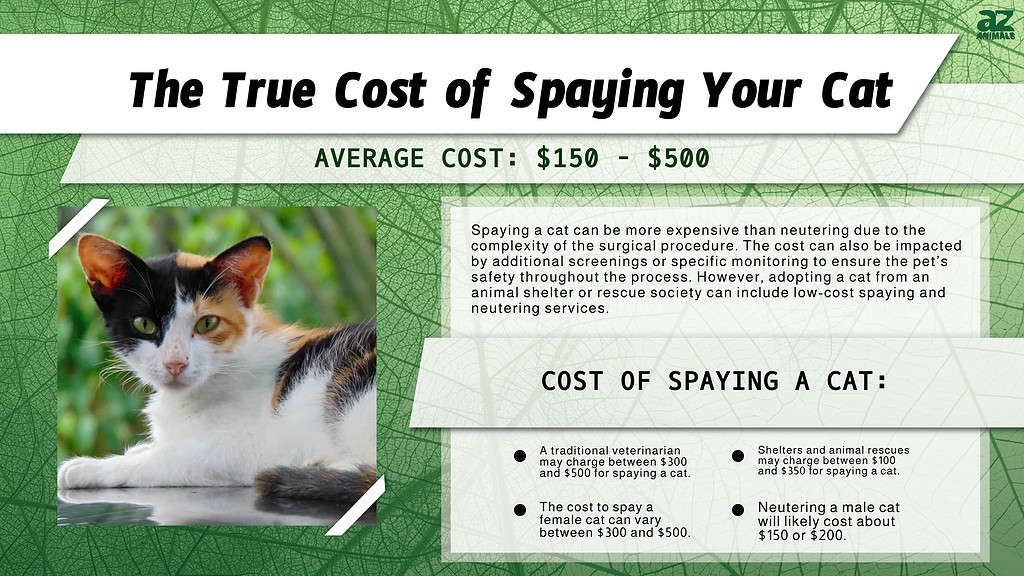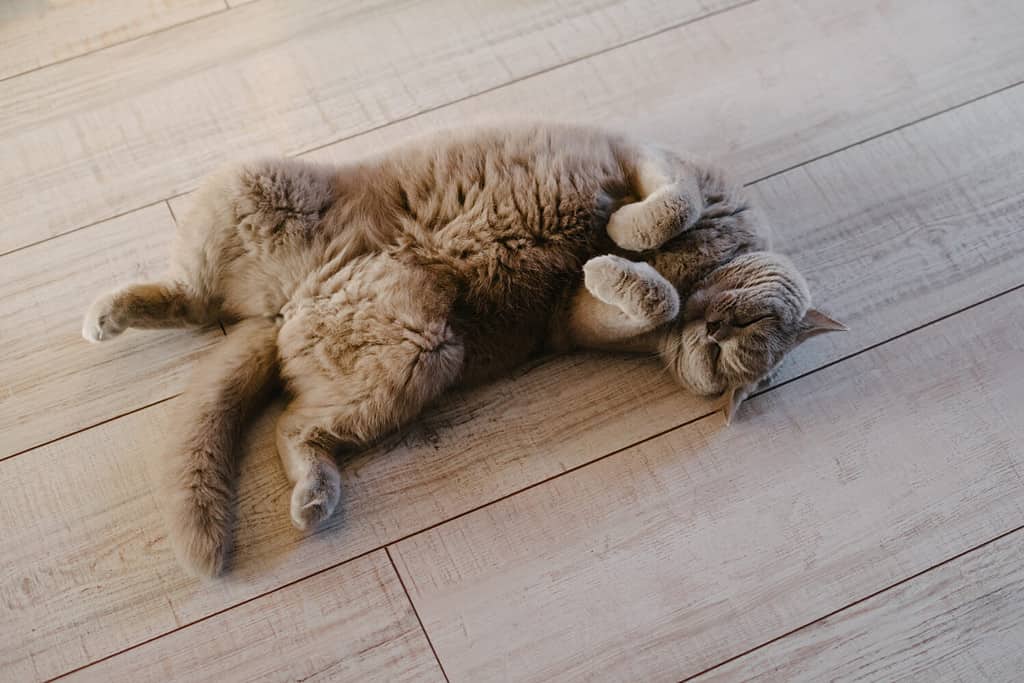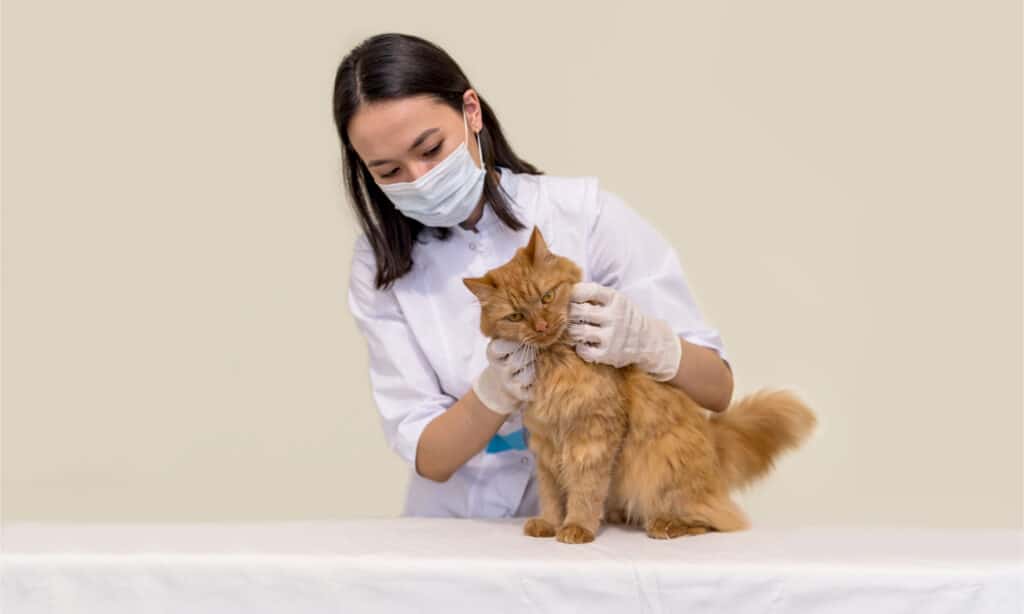Spaying and neutering cats is a common practice and an important step for any cat owner to take. The procedure is a vital part of controlling the animal population, reducing the number of stray or feral cats in neighborhoods, and preventing medical issues later in a cat’s life. This article goes over how much you should expect to pay to spay or neuter your cat and dives into the reasons behind the cost.

What is the true cost of spaying your cat?
The truth is, the cost to spay a cat varies, but it could cost you up to $500.
A traditional veterinarian may charge between $300 and $500. Shelters and animal rescues, which may have access to equipment, volunteer services, or donations to offset the cost, may be between $100 and $350. However, complications during and after the procedure may impact the total price. For example, if your cat is in heat or pregnant, that may impact the price of the services.
What is spaying or neutering a cat?
The terms “spay” and “neuter” are used differently for male and female cats. To “spay” a cat refers to a surgery that sterilizes female cats. When vets do this operation in the United States, it involves removing the cat’s ovaries and uterus. This operation is called an “ovariohysterectomy.” When veterinarians in Europe perform this procedure, it is more common that they only remove the ovaries. This operation is called an “ovariectomy.”
Surgical sterilization of a male cat is called “neutering.” Sometimes you may also hear it referred to as “castration.” This procedure removes the cat’s testicles. Even though “neuter” refers to removing reproductive organs and is not male or female-specific, people typically describe “neutering” a male cat and “spaying” a female cat. However, there is some confusion around the distinction between the terms and non-veterinary professionals may use the terms interchangeably.

How much does it cost to spay a cat?
In general, you will find that the cost to spay or neuter a cat will vary depending on where you live in the United States. If you live in a city or area with an overall higher cost of living, you can expect to pay a higher cost to spay or neuter your pet.
Although the cost to spay a cat can vary, you can expect the operation to cost between $300 and $500 for a female cat. If you are seeking to neuter your male cat, the operation will likely cost about $150 or $200.
Why is spaying a cat so expensive?
It often surprises female cat owners to discover that spaying can be more expensive than neutering. This is because spaying is a more complex surgical procedure, which involves surgery in the cat’s abdominal cavity to remove the ovaries and uterus. In contrast, neutering does not require this level of invasive procedure. Additionally, if you choose to do screenings or specific monitoring to ensure your pet’s safety throughout the process, the cat’s surgery may end up being more expensive. Overall, though, you can expect that some veterinary clinics will charge different rates than others, based on their specific offerings, staffing, and other factors.
If you adopt your cat from an animal shelter or rescue society, you may benefit from animal shelter practices that can include low-cost spaying and neutering services.
What is the best age to spay a cat?
You should spay or neuter your cat when they reach sexual maturity, which is often around five months old. While some vets have begun performing the procedure earlier, when cats are around four months old, five months is more common. Most vets recommend spaying your cat no later than around the five to six-month age mark if possible. This allows you to avoid the negative experiences of having a female cat in heat, avoid pregnancy, and avoid potentially spaying your cat when she is in heat. That said, vets can spay or neuter adult cats later in life. There is no age cutoff.
Is it worth spaying an indoor cat?
Yes, it is worth spaying your indoor cat! Regardless of which breed of cat you have, spay or neuter your pet.
First, even if you plan to keep your cat inside at all times, accidents do happen and you never know if your cat may escape out your front door someday. Yet even if your cat does remain safely indoors, there are other benefits to spaying your cat that can make the procedure well worthwhile.
Second, spaying cats can bring benefits to your cat’s health. Having the ovariohysterectomy procedure removes the uterus, which can help prevent a condition called pyometra, which can be life-threatening. Spaying your cat also lowers the risk of your cat developing mammary cancer.
Third, spaying your cat can prevent the emotional swings and loud noises that female cats in heat may make. Spaying your cat prevents your cat from going into heat and therefore eliminates the nuisance behavior.
Does it cost more to spay a cat in heat?
Although you can spay your cat when it is in heat and this does have a significant health risk, it can be more expensive. This is because spaying a cat in heat often requires extra surgery time, leading to additional charges for the time. You can keep it simple by getting your cat spayed before she goes into heat for the first time. Typically, vets recommend getting kittens spayed by the time they are six months old since most female cats go into heat for the first time when between six and nine months old.
What are the benefits of spaying a cat?

Consider the benefits vs. the cost of spaying a cat, remembering that it will help your pet live a healthy life.
©Alice Rodnova/Shutterstock.com
Here are three reasons that both you and your pet will benefit from spaying your cat.
- Spaying your female cat lessens her risk of certain health problems, including mammary cancer. Neutering your male cat also reduces his chances of developing testicular cancer and other health conditions.
- Intact female cats may exhibit natural behavior associated with mating, especially when in heat. This can include wanting to roam outdoors, howling, acting frantic, or behaving in a clingy way. If intact, your female cat will be attractive to male cats, who are on the lookout for a mate. Unfortunately, these natural behaviors can make some feel that the cat is a nuisance or causing havoc. In the worst scenarios, this may lead some owners to abandon their cats in frustration. However, on the more positive side, pet owners who get their cats spayed often report that their female cat behaves in a much calmer manner after their surgery.
- With millions of stray cats on the streets, many live outdoors on the streets for their entire lives. Not only is this unfortunate for the animals, but it can be a self-perpetuating cycle that causes pets to produce even more unwanted litters and expand the feral pet population. Stray cats are vulnerable to starvation, abuse, disease, injury, and tragic deaths. You can show your care for these animals by spaying your cat and preventing her from contributing to the cat overpopulation.
What should you expect when spaying your cat?
Once you decide to get your cat spayed, you will want to reach out to your pet’s vet. Some people may be worried or anxious for their pet. However, there is no need to worry! Spaying and neutering of a cat, either female or male, should only be performed by licensed veterinarians. But when done by qualified vets, both of these procedures are routine surgeries. Vets do these procedures very regularly, and complications are relatively rare.
Before scheduling a surgical appointment, your vet will do a physical exam with your cat. This could also include blood work or testing as a precaution to keep your pet safe. After your cat’s test results come back, your vet’s office will work with you to schedule an appointment.
When the day comes, your cat will be put under general anesthesia. This will ensure that they do not experience too much pain or anxiety during the operation to reduce any pain or discomfort. Once the surgery is done, your vet’s office will give you instructions. They will ensure you are equipped to take care of your pet as they recover. They may also send you home with pain medication to give your pet in the days after the surgery. After just a few days, most cats are back to their normal selves. After two weeks, your female cat’s surgical incision should be healed. However, if you have any concerns throughout the process, you can always reach out to your local veterinarian.

Your vet will perform the surgery on your cat. They will be glad to answer your questions along the way.
©Irzhanova Asel/Shutterstock.com
The photo featured at the top of this post is © Anna Krivitskaya/Shutterstock.com
Thank you for reading! Have some feedback for us? Contact the AZ Animals editorial team.






